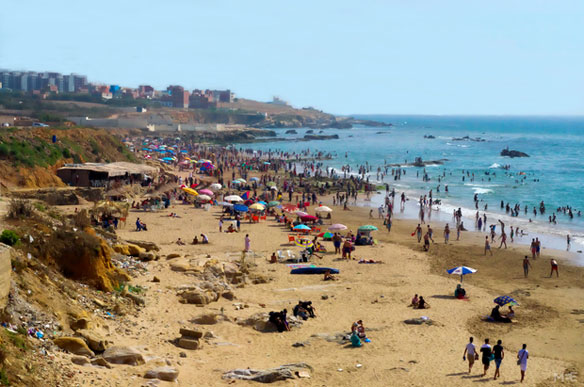Desirable coastal areas are being stripped of their beachfronts by the construction need for sand

Asilah’s beaches are a popular tourist attraction in the summer months. Captions and Photo source: © MEE/Matthew Greene
Originally published in, and courtesy of: © Middle East Eye, August 4th, 2016. All rights reserved.
For much of the year the northern Moroccan coastal city of Asilah is quiet and relaxed. But come summer the population swells, absorbing both crowds of seasonal residents as well as an influx of tourists. Visitors come for the cool weather, the affordable prices and above all to enjoy Asilah’s wide sandy beaches.
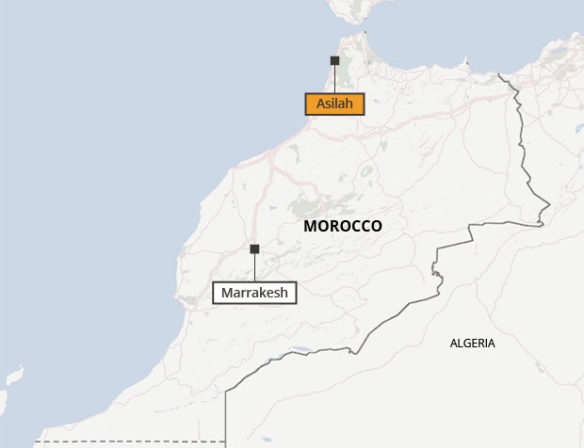
Yet during the last decade, Asilah’s beaches have been ravaged. Their natural beauty has been devastated due to years of sand mining, whereby large stretches of beachfront have been almost stripped bare of their sand. Their condition threatens severe long-term environmental damage as well as undermining the industry that is the main driving force behind this city’s economy.
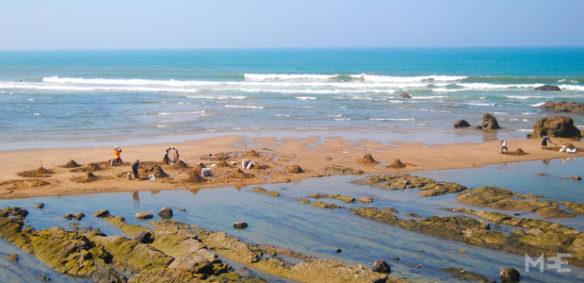
Workers mine sand from an Asilah beach in 2012. Photo source: Miriam Gutekunst / transformations-blog.com
Sand mining peaked between 2012 and 2014, when Asilah witnessed a sharp increase in the construction of apartments, homes, hotels and resort projects capitalising on a favourable property market. “They were building like mad men,” recalls Fouad Maslouhi, a textile trader and lifelong Asilah resident. He says that most of the investment came not from locals but from real estate developers and builders based in Tangier, Fez and elsewhere.
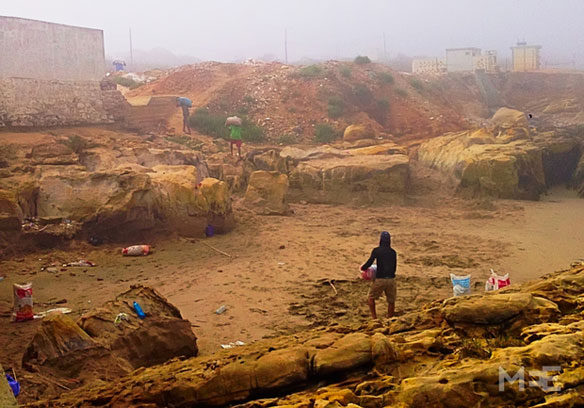
A group of men dig sand from a hidden pocket of beach when the tide retreats. Captions and Photo source: © MEE/Matthew Greene
Amid the development boom, some builders began seeking out a cheaper alternative to purchasing cement, opting to exploit the sand of nearby beaches with which to mix their own concrete. “They just assumed that the sand would naturally replace itself,” says Kamal Arrifi, a certified mason who remembers the period well. After a few years of steady mining, it became clear that nature was struggling to keep pace with the unnatural removal.

A worker fills a flour sack with sand on a slice of shoreline hidden by the cliff above. Captions and Photo source: © MEE/Matthew Greene
Arrifi says that most of those doing the digging were younger Moroccan men from around the city, desperate for work and money, adding: “It was reliable work and pay.” Groups of young men and boys as young as 12 would come down to the beach with shovels to fill up used flour sacks with sand before hoisting them onto carts to be moved to nearby work sites. In areas where the digging was most extreme, the beach was left resembling the surface of the moon.

The extent of sand removal and cliff erosion: unfinished housing sits in the background. Captions and Photo source: © MEE/Matthew Greene
Asilah is not the only Moroccan city to have suffered sand exploitation. Similar operations have been documented along the country’s Atlantic shoreline in nearby Larache, as well as in Kenitra and as far south as Dakhla, sometimes on an industrial scale so large that entire kilometres of coastline have been destroyed. The common culprit is a demand for cement for which sand is an essential ingredient.
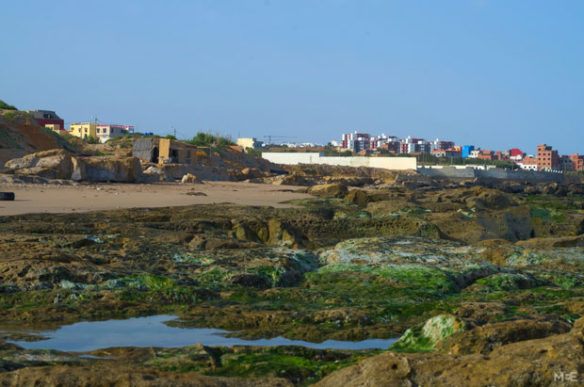
Surface rock has become more exposed as a consequence of sand mining. Captions and Photo source: © MEE/Matthew Greene
Some residents in Asilah believe sand mining is only a symptom of a more murky reality: the world of local government bureaucracy, which has allowed construction to blossom without regulation. “I don’t know how people came to realise that they didn’t need permits or plans, but it was universal knowledge,” says Jan Williams, an American expat who has lived in Asilah for the past 20 years. “Everyone knew that it was cheaper to pay fines than acquire the proper paperwork.”
She believes the problem reflects the mood of post-Arab Spring Morocco. “A town engineer told me that in the past that they [the authorities] would have come and knocked down any illegal additions. Now, he said: ‘What would we do if someone pours gasoline over his head and sets himself on fire? We would have a problem, like in Tunisia’,” referring to Mohamed Bouazizi, the Tunisian street vendor whose self-immolation in 2011 was widely recognised as the catalyst of the Tunisian Revolution which went on to inspire the Arab Spring.
Today, sand mining in Asilah has slowed to a trickle. Many housing projects sit empty and unfinished, a result of the money in the real estate market drying up. The environmental impact of the period, however, remains visible.

The natural wall between the sea and housing is now giving way to erosion. Captions and Photo source: © MEE/Matthew Greene
Behind Asilah’s old medina, rock exposure reveals where high quantities of sand removal occurred. The absence has also led the shoreline to move further inland, allowing incoming tides to push past what was previously their natural threshold.
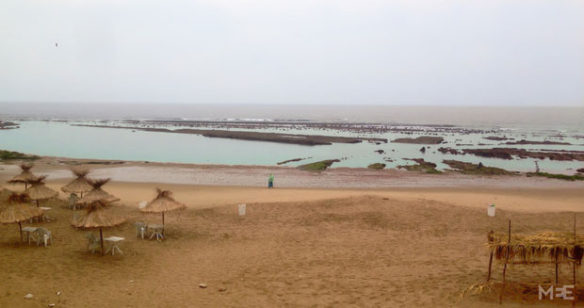
The low tide reveals the shore retreat and sediment loss from sand mining. Captions and Photo source: © MEE/Matthew Greene
According to Abdou Khouakhi, a Moroccan oceanographer, surface loss and shore retreat are key warning signs of potential environmental and structural danger. “This may cause erosion and enable waves and storm surges to threaten inland and low-lying areas.”
He adds that it is important to look at beaches as part of a wider ecosystem that offers “a valuable environment and habitat for many species of fauna and flora”. The possible consequences of sand mining are not confined to shores, but may spread to estuaries and other habitats such as dunes and marshes that have significant relationships to the ocean.

Illegal beach sand mining, Morocco. This photo was taken on the North Coast of Morocco, in Larache area, near Tangier (between 2005 and 2009). Photo courtesy of © SAF – Coastalcare.org
“It has always been about money, and that won’t ever change…”
It is the economic and cultural toll of sand mining that has finally persuaded the city to address the issue. This summer, sand was imported to a handful of Asilah’s beaches in an attempt to make them more accommodating and presentable for the tourist season. The measure, however, is only a temporary fix to a larger problem.
In Khouakhi’s opinion, Morocco needs to “adopt conservation and preservation methods rather than ‘defence’ approaches” that take the wider ecosystem into consideration. He prescribes an all-encompassing programme that emphasises stabilisation, vegetation and beach nourishment in addition to avoiding any future sand mining.

Illegal beach sand mining, Morocco. This photo was taken on the North Coast of Morocco, in Larache area, near Tangier (between 2005 and 2009). Photo courtesy of © SAF – Coastalcare.org
But concerned residents express little confidence in the government’s willingness to take the long-term health of the environment into account, despite Morocco’s recent commitments to sustainable development policies. Doing so, they argue, conflicts with the state’s appetite for economic growth and profit. “It has always been about money, and that won’t ever change,” says Arrifi.
He points from a dirt road overlooking a small inlet of coast removed from beachgoers as a group of young men shovel sand into wheelbarrows. “If they [government] really cared, they would stop this.”

